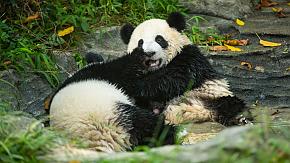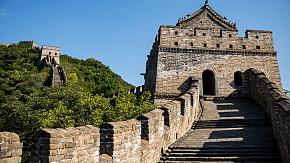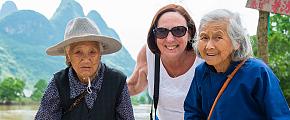The 4 Things You Must Do in Chengdu
It might not be as well-known as the big cities of Beijing, Shanghai or Guangzhou, or even as more touristic destinations such as Xi'an, Hangzhou or Guilin, but, with an urban population of more than 10 million people, this lively city in Southwest China has amazing things to offer to its visitors and no tour of China would be complete without coming to the capital of Sichuan province: Chengdu, the home of the giant panda.
Take a Selfie With the Pandas
Surely they are the main reason why you decided to include Chengdu in your tour around China. Ask any foreigner to name 3 things about China and "pandas" will definitely be one of the answers.
 Pandas in Chengdu, China
Pandas in Chengdu, China
Not only in Chengdu, pandas are the main attraction of the whole Sichuan province. You'll notice it as soon as you get off the plane/train that has taken you to Chengdu. Every single product from Chengdu or related to the city has a panda printed on its package. Commercials, paintings, statues... the city's tourism, both domestic and international, relies on these cute black and white bears, and Chengdu knows how to advertise them. Take a minute to look for the #chengdu hashtag on Instagram and you will see lots of photos of a statue of a giant panda climbing a building of one of the most famous shopping malls in downtown Chengdu.
Sichuan province is the main habitat for these bamboo eaters. There are seven nature reserves and nine scenic parks in what are known as the Sichuan Giant Panda Sanctuaries, home to more than 30% of the world's giant pandas.
The Sichuan Wolong Giant Panda Nature Reserve is only 80 miles away from Chengdu, but if you want to see pandas without leaving Chengdu, you can do so at the Chengdu Research Base of Giant Panda Breeding (成都大熊猫繁育研究基地), located in the northern part of the city. You can take the metro line 3 and get off at Panda Avenue Station (the name could not get any better). From there, a 10-minute ride by bus will get you to the entrance. Go early if you want to avoid the crowds (doors open at 7:30 am), especially on weekends. Whenever possible, avoid going during Chinese national holidays. Most hotels arrange private tours for their guests as well. If you arrive in the morning (usually from 8 to 10 am) you will probably find the pandas playing and eating. In the afternoon, most of them will be taking a nap, a very long one.
Scientists estimate that there are less than 2,000 pandas in the world. They are an endangered species that needs our help to avoid extinction. We can affirm that this breeding facility has been doing an outstanding job since it was founded in 1987 with only 6 pandas. The current population in this research and breeding center is approximately 200 pandas. It covers an area of 100 hectares, so be ready to walk if you want to see all the dens. And make sure to get a map at the entrance if you don't want to get lost.
If you are expecting a usual zoo with caged animals, you will be happy to find a totally different facility. Dens are quite big, full of trees, ponds and swings for the animals to play with. You will surely have the chance to see some of them from just a few meters while they are enjoying their food (a view you will remember for the rest of your life), and take a nice selfie with them in the background and get hundreds of likes on your social networks. But, in other cases, you will struggle and spend some time searching before finding them lying on a tree branch and then you will feel like Hugo Weigold, a German Zoologist who was the first Westerner to see a live giant panda (a cub, which he bought) back in 1916.
But giant pandas are not the only species you will find here. There are also red pandas: but do not expect a red-and-white version of the "common" ones. Red pandas look like brownish racoons. They are a different size, form and color than their big cousins, but have the same cuteness. Since they are native to Southwestern China and the Himalayas, this will probably be your best chance to see them. Besides pandas, other endangered species like black-necked cranes and white storks can be seen at the Chengdu Research Base of Giant Panda Breeding.
Do not leave without wandering around the three main halls (Giant Panda Hall, Vertebrate Hall and Butterfly Hall), as well as the museum and the bookshop. Some people claim that they have been able to leave the gift shop without buying a panda teddy, but that is because they bought theirs from one of the street vendors that park their filled-with-teddies vans at the exit and wait for the visitors to come out.
Set Your Mouth on Fire Eating Hot Pot
Anyone who has travelled or read about China knows about this delicious dish, hot pot (火锅). A big pot of boiling soup is placed in the center of a table with a sunken burner, and a variety of raw meat and vegetables is provided for diners to cook in the soup until it is done to their satisfaction.
 Hot Pot in Sichuan, China
Hot Pot in Sichuan, China
It is one of the most famous dishes throughout the whole country, but Sichuan (and its neighboring municipality, Chongqing) takes the hot pot to another level, to the spiciest level. Sichuan food is well-known for its spicy flavor and hot pot is no exception.
The base is made using beef or pork stock and spiced oil. Dozens of chili peppers floating in lava-like soup let diners know that Sichuan hot pot is not for cowards. Choose your pot: it can be entirely spicy or half spicy and half clear broth. Then start throwing the foodstuff into the pot, pick it up using those long chopsticks, and make it more bearable with the help of some dipping sauce made of sesame oil, chopped spring onions, and crushed garlic. The longer you let the soup simmer, the more your tongue will get numb due to those Sichuan peppercorns floating around. Beef, pork, lamb, mushrooms, potatoes, noodles, spinach leaves; anything can be cooked in the hot pot to make you feel that adding a few days in Chengdu to your China tour was the best idea you ever had.
A slightly different kind of hot pot, also very popular in Sichuan, is called Chuan Chuan (串串). Instead of having the raw ingredients brought to the table, diners pick them by themselves from large refrigerators, where they are impaled on skewers (that's the meaning of Chuan Chuan). Then those skewers are directly placed in the soup and taken out when the contents are cooked.
Hot pot restaurants are everywhere in Chengdu. There is at least one (or more than one) on every street, where both locals and visitors can be seen in big groups sitting around large circular tables, or in couples enjoying a romantic night. Birthday parties, company dinners; hot pot in Chengdu is not just a simmering dish, it is a passion. There are many hot pot restaurants that stay open 24 hours a day since it is not unusual for locals to go there after a long night at the karaoke, whatever the time.
Visit the World’s Biggest Buddha at Leshan
Not in Chengdu but in the nearby city of Leshan, carved out of a cliff at the confluence of three rivers, the Min, Qingyi and Dadu, the Giant Buddha of Leshan (乐山大佛) rests calmly facing the Mount Emei while thousands of tourists take pictures from its base, from the top of the hill and from the cruises that pass in front of him every day. Together with the Mount Emei Scenic Area, it was listed as a UNESCO World Heritage Site in 1996.
 Giant Buddha of Leshan
Giant Buddha of Leshan
"The mountain is a Buddha and the Buddha is a mountain". This local saying about the sitting statue depicting Maitreya Buddha could not be more right. 71 meters (233 ft) high and 28 meters (92 ft) wide at the shoulders. 3-meter (10 ft) eyes and 7-meter (23 ft) ears, as you can imagine, it is the tallest stone Buddha statue in the world. Useful advice: it is even more impressive than what it seems in photographs. Hiking up the hill in order to get a top view will take you about 15 minutes: it's not as steep as it seems and totally worth it. The hill contains many beautiful pagodas and pavilions.
The Buddha was built in the 8th century during the Tang Dynasty. The project was overseen by a Chinese Monk called Haitong who thought the Buddha would calm the turbulent waters that made the river difficult to navigate. Believe it or not, so many rocks were carved out of the mountain and fell in the river that they did create a channel that let the boats pass easily. Legend has it that, during the construction, the project lacked funding and Heitong gouged out his eyes "to show piety and sincerity". Decades later, a local governor continued the project and the Giant Buddha was finally completed in 803. During the construction, a drainage system was built inside the Buddha in order to protect it from corrosion. It seems they did a pretty good job because, to this day, it still works.
Twelve centuries have taken their toll: weathering and air pollution have degraded the surface of the Giant Buddha. Governments have undertaken several restoration works.
Getting from Chengdu to Leshan is not difficult. You can take a bullet train from Chengdu East Railway Station which takes about one hour; or a bus from Xinnanmen Bus Station, that will get you there in 2 hours. Once in Leshan, take a public bus to the Leshan Giant Buddha Scenic Area, or even a ferry if you don't want to walk up the hill and just want a panoramic view. The entrance fee includes Wulong Temple and Mahao Cliff Tomb.
If you wake up early enough you can visit the Giant Buddha and be back in Chengdu for dinner. If you decide to stay the night (and feel brave enough), Qiaojiao Beef and Doufu Nao (tofu brain) are two of the most popular dishes that visitors can eat in Leshan. A kind of steamed dumplings called Shaomai are a safer choice if you need some rest from spicy food. The following day, you should consider a quick visit to Mount Emei (峨眉山), one of the Four Sacred Buddhist Mountains of China, before returning to Chengdu. Take the bus from Leshan and you'll be there in one hour. Walk your way up to the top of the mountain or use the cable car to get to the Gold Summit. The huge statue of Samantabhadra, nice temples and maybe some monkeys will be waiting for you there. Take some warm clothes; it is quite cold up there.
Get Lost in the New Century Global Center
When we think about the largest buildings in the world, the Burj Khalifa in Dubai is the one that usually comes to our minds in the first place, because it is the tallest. But few people outside China know that the world's biggest building by floor area is not in the Middle East or in America, but in the south of Chengdu; the New Century Global Center (新世纪环球中心).
It is "only" 100 meters (330 ft) tall but has a floor space of almost 19 million square feet. You could fit 3 Pentagons, or 20 Sydney Opera Houses, inside its 18-story glass and steel frame structure. Check it out on Google Maps to get an idea of its huge proportions in relation to other near buildings.
It opened in September 2013 amid controversy over a corruption scandal. Needless to say, it has everything you can expect in a shopping mall. And more; much more. In addition to hundreds of stores, offices and restaurants of all kinds, there is a 14-screen IMAX cinema, a Mediterranean village, a water park, an ice-skating rink and luxury hotels. The crown jewel is a 100-feet long artificial beach, where a giant (446x98 ft) LED screen offers sunrises, sunsets and breezes in a city almost one thousand miles away from the sea.
Quick Question
What Our Clients Say
Explore the latest verified reviews of Odynovo's travel services on Tripadvisor, Google, Trustpilot, Product Review and more trusted platforms.









